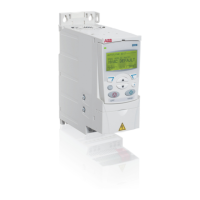Actual signals and parameters 229
Group 40: Process PID set 1
Code Description Range Resolution Default S
4001
GAIN
0.1 … 100.0 0.1 2.5
Defines the PID controller’s gain.
• At 0.1, the PID controller output changes one-tenth as much as the error value.
• At 100, the PID controller output changes one hundred times as much as the error
value.
Use the proportional gain and integration time values to adjust the responsiveness of
the system.
• Low value for proportional gain and a high value for integral time ensures stable
operation, but provides sluggish response.
If the proportional gain value is too large or the integral time too short, the system can
become unstable.
Procedure:
• Initially, set:
• 4001 GAIN = 0.1.
• 4002 INTEGRATION TIME = 20 seconds.
• Start the system and see if it reaches the setpoint quickly while maintaining stable
operation. If not, increase GAIN (4001) until the actual signal (or drive speed)
oscillates constantly. It may be necessary to start and stop the drive to induce this
oscillation.
• Reduce GAIN (4001) until the oscillation stops.
• Set GAIN (4001) to 0.4 to 0.6 times the above value.
• Decrease the INTEGRATION TIME (4002) until the feedback signal (or drive speed)
oscillates constantly. It may be necessary to start and stop the drive to induce this
oscillation.
• Increase INTEGRATION TIME (4002) until the oscillation stops.
•Set INTEGRATION TIME (4002) to 1.15 to 1.5 times the above value.
• If the feedback signal contains high frequency noise, increase the value of
Parameter 1303 FILTER AI1 or 1306 FILTER AI2 until the noise is filtered from the
signal.

